Opinion & Analysis
Sand Saves: How often should you actually get “up-and-down” from the bunker based on your handicap?
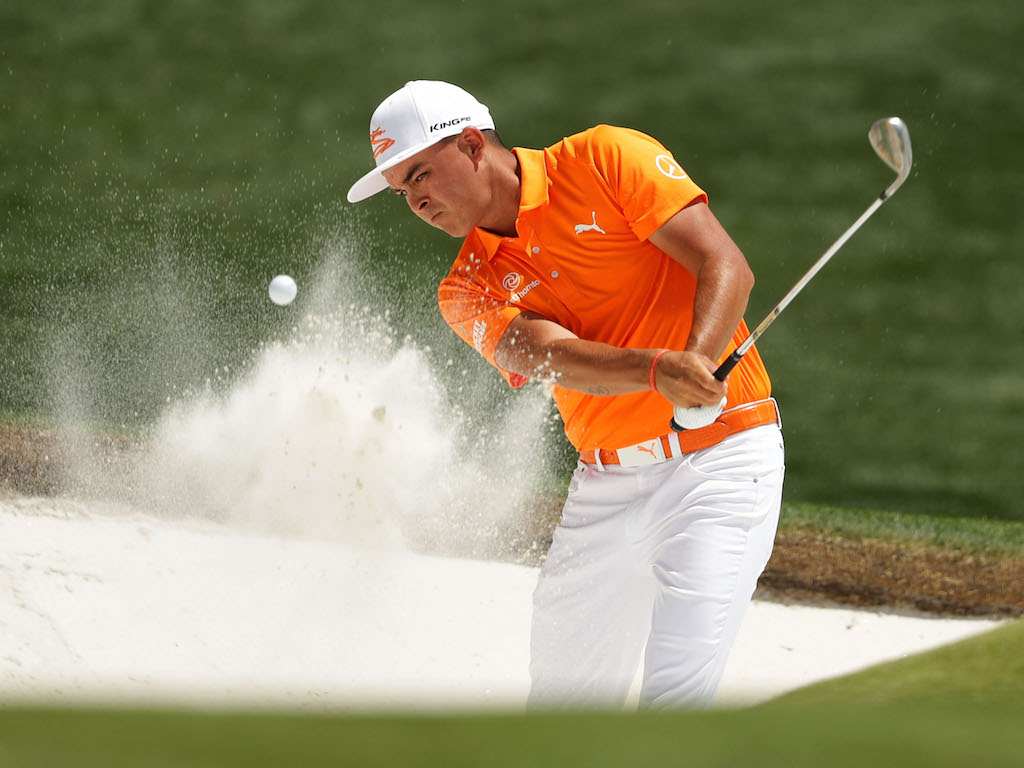
This is a follow-up to my recent article,“How often should you … get ‘Up-and-Down’ based on your handicap?” That article focused on short game shots around the green that were NOT sand shots. If you have not read it, please do as I will not be repeating all of the supporting points in this article.
The traditional “Sand Save” stat has long been the accepted measure of skill from greenside sand. The chart below shows average performance in this area for PGA Tour players and an array of handicap levels. It refers to sand shots around the green and within 50 yards of the hole.
How do you fit in?
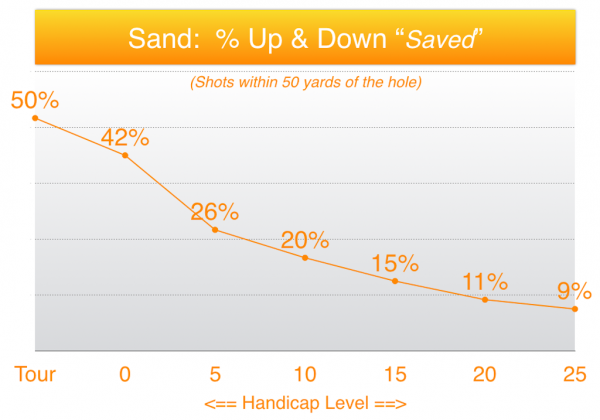
While sand saves, or “up and downs,” are nice, I do not believe them to be an appropriate or accurate measure of short game skill. Sand shots are quite a bit different than chipping or pitching, not only because they are a very different skill, but also because they tend to occupy a much smaller part of the overall game.
Non-sand short game shots generally range from a low of four or five shots per round at the top levels of the game, to as many as 15 shots at the other end. For perspective, the typical 15-19 handicap golfer averages about 10 non-sand short game shots per round. Shots from the sand are relatively rare, usually only 1 to 3 per round, and the 15-19 handicap golfer averages less than two.
Despite their reduced role, however, sand shots can have a meaningful impact on score. Why? It’s due to the difficulty of these shots and their high incidence of ERRORs, which I will discuss more below.
Again, I do NOT believe that “up and downs” are an appropriate or accurate measure of short game skill for two reasons:
- An up-and-down is actually the combination of two skills: Short Game and Putting.
- The stat totally ignores ERRORS, or shots that miss the green.
In my 30+ years of studying golf performance at all skill levels, I have found that FREQUENCY and SEVERITY of bad shots (errors) do so much more to influence a player’s scoring level than do all the good shots. I did not create my stat program to expose the errors in the game, but my early work and analysis revealed exactly how important they are, as well as their glaring omission from existing, traditional stats. Accordingly, I built the ability to capture data on the common errors in the game into ShotByShot.com.
The true measure of a player’s short game skill is their Strokes Gained in that facet. BUT, that is simply a number — a positive number is good, and a negative number is not so good. So how then to best display the skill that is associated with the Strokes Gained number? I believe the combination of the three stats below to be the correct way to display skill from the sand:
- Average putting distance when the green is successfully hit.
- Percent of shots hit to within 8 feet of the hole.
- Percent of errors, or shots that miss the putting surface.
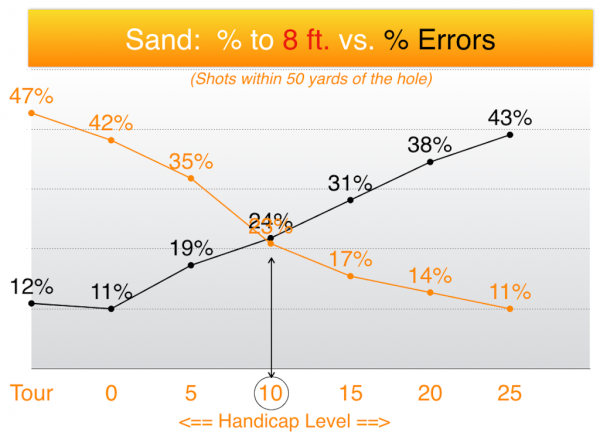
In the chart above, the orange line represents the percentage of shots that the various levels of handicap golfers hit to within 8 feet of the hole. Why 8 feet? Our data has told us that this distance represents a good shot, just as 5 feet does in Chipping and Pitching around the green. The black line represents shots that miss the green (errors). For example, if you are the average 15-handicap golfer, you should be getting about one of every six sand shots to within 8 feet. You’ll miss the green with about one in every three sand shots, however, so you’ll make twice as many errors as you make good shots.
Note that the two lines cross at about a 10 handicap. A 10 handicap is actually a better golfer than 90 percent of the people who play the game regularly. Yet for every sand shot that they successfully get to within 8 feet of the hole, they are also sculling or leaving one in the sand and missing the green altogether. Further, these errors can lead to even more difficult positions, large numbers and real frustration.
Finally, a fear of the greenside sand can dramatically impact confidence and ability to hit greens. If you are having difficulty from the sand, I suggest that you first consult with your pro about your sand wedge. Is it the right loft and bounce for your game and the condition of your course’s sand? Then work to gain confidence in getting OUT. Just focus on getting the ball on the green. Forget the about the “save” until you can practice enough to reliably play the array of sand shots required with confidence.
If you’d like to see how greenside errors are affecting your game, as well as where you stack up to golfers in your handicap level, you can register for a FREE TRIAL of my strokes-gained analysis at ShotbyShot.com
- LIKE153
- LEGIT9
- WOW2
- LOL1
- IDHT2
- FLOP1
- OB1
- SHANK5
19th Hole
Vincenzi’s 2024 Texas Children’s Houston Open betting preview

As the Florida swing comes to an end, the PGA Tour makes its way to Houston to play the Texas Children’s Houston Open at Memorial Park Golf Course.
This will be the fourth year that Memorial Park Golf Course will serve as the tournament host. The event did not take place in 2023, but the course hosted the event in 2020, 2021 and 2022.
Memorial Park is a par-70 layout measuring 7,432 yards and features Bermudagrass greens. Historically, the main defense for the course has been thick rough along the fairways and tightly mown runoff areas around the greens. Memorial Park has a unique setup that features three Par 5’s and five Par 3’s.
The field will consist of 132 players, with the top 65 and ties making the cut. There are some big names making the trip to Houston, including Scottie Scheffler, Wyndham Clark, Tony Finau, Will Zalatoris and Sahith Theegala.
Past Winners at Memorial Park
- 2022: Tony Finau (-16)
- 2021: Jason Kokrak (-10)
- 2020: Carlos Ortiz (-13)
In this article and going forward, I’ll be using the Rabbit Hole by Betsperts Golf data engine to develop my custom model. If you want to build your own model or check out all of the detailed stats, you can sign up using promo code: MATTVIN for 25% off any subscription package (yearly is best value).
Key Stats For Memorial Park
Let’s take a look at several metrics for Memorial Park to determine which golfers boast top marks in each category over their last 24 rounds:
Strokes Gained: Approach
Memorial Park is a pretty tough golf course. Golfers are penalized for missing greens and face some difficult up and downs to save par. Approach will be key.
Total Strokes Gained: Approach per round in past 24 rounds:
- Tom Hoge (+1.30)
- Scottie Scheffler (+1.26)
- Keith Mitchell (+0.97)
- Tony Finau (+0.92)
- Jake Knapp (+0.84)
Strokes Gained: Off the Tee
Memorial Park is a long golf course with rough that can be penal. Therefore, a combination of distance and accuracy is the best metric.
Total Strokes Gained: Off the Tee per round in past 24 rounds:
- Scottie Scheffler (+0.94)
- Kevin Dougherty (+0.93)
- Cameron Champ (+0.86)
- Rafael Campos (+0.84)
- Si Woo Kim (+0.70)
Strokes Gained Putting: Bermudagrass + Fast
The Bermudagrass greens played fairly fast the past few years in Houston. Jason Kokrak gained 8.7 strokes putting on his way to victory in 2021 and Tony Finau gained in 7.8 in 2022.
Total Strokes Gained Putting (Bermudagrass) per round past 24 rounds (min. 8 rounds):
- Adam Svensson (+1.27)
- Harry Hall (+1.01)
- Martin Trainer (+0.94)
- Taylor Montgomery (+0.88)
- S.H. Kim (+0.86)
Strokes Gained: Around the Green
With firm and undulating putting surfaces, holding the green on approach shots may prove to be a challenge. Memorial Park has many tightly mowed runoff areas, so golfers will have challenging up-and-down’s around the greens. Carlos Ortiz gained 5.7 strokes around the green on the way to victory in 2020.
Total Strokes Gained: Around the Green per round in past 24 rounds:
- Mackenzie Hughes (+0.76)
- S.H. Kim (+0.68)
- Scottie Scheffler (+0.64)
- Jorge Campillo (+0.62)
- Jason Day (+0.60)
Strokes Gained: Long and Difficult
Memorial Park is a long and difficult golf course. This statistic will incorporate players who’ve had success on these types of tracks in the past.
Total Strokes Gained: Long and Difficult in past 24 rounds:
- Scottie Scheffler (+2.45)
- Ben Griffin (+1.75)
- Will Zalatoris (+1.73)
- Ben Taylor (+1.53)
- Tony Finau (+1.42)
Course History
Here are the players who have performed the most consistently at Memorial Park.
Strokes Gained Total at Memorial Park past 12 rounds:
- Tyson Alexander (+3.65)
- Ben Taylor (+3.40)
- Tony Finau (+2.37)
- Joel Dahmen (+2.25)
- Patton Kizzire (+2.16)
Statistical Model
Below, I’ve reported overall model rankings using a combination of the five key statistical categories previously discussed.
These rankings are comprised of SG: App (24%) SG: OTT (24%); SG: Putting Bermudagrass/Fast (13%); SG: Long and Difficult (13%); SG: ARG (13%) and Course History (13%)
- Scottie Scheffler
- Wyndham Clark
- Tony Finau
- Joel Dahmen
- Stephan Jaeger
- Aaron Rai
- Sahith Theegala
- Keith Mitchell
- Jhonnatan Vegas
- Jason Day
- Kurt Kitayama
- Alex Noren
- Will Zalatoris
- Si Woo Kim
- Adam Long
2024 Texas Children’s Houston Open Picks
Will Zalatoris +2000 (Caesars)
Scottie Scheffler will undoubtedly be difficult to beat this week, so I’m starting my card with someone who I believe has the talent to beat him if he doesn’t have his best stuff.
Will Zalatoris missed the cut at the PLAYERS, but still managed to gain strokes on approach while doing so. In an unpredictable event with extreme variance, I don’t believe it would be wise to discount Zalatoris based on that performance. Prior to The PLAYERS, the 27-year-old finished T13, T2 and T4 in his previous three starts.
Zalatoris plays his best golf on long and difficult golf courses. In his past 24 rounds, he ranks 3rd in the category, but the eye test also tells a similar story. He’s contended at major championships and elevated events in the best of fields with tough scoring conditions. The Texas resident should be a perfect fit at Memorial Park Golf Club.
Alex Noren +4500 (FanDuel)
Alex Noren has been quietly playing some of his best golf of the last half decade this season. The 41-year-old is coming off back-to-back top-20 finishes in Florida including a T9 at The PLAYERS in his most recent start.
In his past 24 rounds, Noren ranks 21st in the field in Strokes Gained: Off the Tee, 30th in Strokes Gained: Around the Green, 25th in Strokes Gained: Total on long and difficult courses and 21st in Strokes Gained: Putting on fast Bermudagrass greens.
In addition to his strong recent play, the Swede also has played well at Memorial Park. In 2022, Noren finished T4 at the event, gaining 2.2 strokes off the tee and 7.0 strokes on approach for the week. In his two starts at the course, he’s gained an average of .6 strokes per round on the field, indicating he is comfortable on these greens.
Noren has been due for a win for what feels like an eternity, but Memorial Park may be the course that suits him well enough for him to finally get his elusive first PGA Tour victory.
Mackenzie Hughes +8000 (FanDuel)
Mackenzie Hughes found himself deep into contention at last week’s Valspar Championship before faltering late and finishing in a tie for 3rd place. While he would have loved to win the event, it’s hard to see the performance as anything other than an overwhelming positive sign for the Canadian.
Hughes has played great golf at Memorial Park in the past. He finished T7 in 2020, T29 in 2021 and T16 in 2022. The course fit seems to be quite strong for Hughes. He’s added distance off the tee in the past year or and ranks 8th in the field for apex height, which will be a key factor when hitting into Memorial Park’s elevated greens with steep run-off areas.
In his past 24 rounds, Hughes is the best player in the field in Strokes Gained: Around the Greens. The ability to scramble at this course will be extremely important. I believe Hughes can build off of his strong finish last week and contend once again to cement himself as a President’s Cup consideration.
Akshay Bhatia +8000 (FanDuel)
Akshay Bhatia played well last week at the Valspar and seemed to be in total control of his golf ball. He finished in a tie for 17th and shot an impressive -3 on a difficult Sunday. After struggling Thursday, Akshay shot 68-70-68 in his next three rounds.
Thus far, Bhatia has played better at easier courses, but his success at Copperhead may be due to his game maturing. The 22-year-old has enormous potential and the raw talent to be one of the best players in the world when he figures it all out.
Bhatia is a high upside play with superstar qualities and may just take the leap forward to the next stage of his career in the coming months.
Cameron Champ +12000 (FanDuel)
Cameron Champ is a player I often target in the outright betting market due to his “boom-or-bust” nature. It’s hard to think of a player in recent history with three PGA Tour wins who’s been as inconsistent as Champ has over the course of his career.
Despite the erratic play, Cam Champ simply knows how to win. He’s won in 2018, 2019 and 2021, so I feel he’s due for a win at some point this season. The former Texas A&M product should be comfortable in Texas and last week he showed us that his game is in a pretty decent spot.
Over his past 24 rounds, Champ ranks 3rd in Strokes Gained: Off the Tee and 30th in Strokes Gained: Total on long and difficult courses. Given his ability to spike at any given time, Memorial Park is a good golf course to target Champ on at triple digit odds.
Robert MacIntyre +12000 (FanDuel)
The challenge this week is finding players who can possibly beat Scottie Scheffler while also not dumping an enormous amount of money into an event that has a player at the top that looks extremely dangerous. Enter McIntyre, who’s another boom-or-bust type player who has the ceiling to compete with anyone when his game is clicking on all cylinders.
In his past 24 rounds, MacIntyre ranks 16th in the field in Strokes Gained: Off the Tee, 17th in Strokes Gained: Around the Green and 10th in Strokes Gained: Total on long and difficult courses.
MacIntyre’s PGA Tour season has gotten off to a slow start, but he finished T6 in Mexico, which is a course where players will hit driver on the majority of their tee shots, which is what we will see at Memorial Park. Texas can also get quite windy, which should suit MacIntyre. Last July, the Scot went toe to toe with Rory McIlroy at the Scottish Open before a narrow defeat. It would take a similar heroic effort to compete with Scheffler this year in Houston.
Ryan Moore +15000 (FanDuel)
Ryan Moore’s iron play has been absolutely unconscious over his past few starts. At The PLAYERS Championship in a loaded field, he gained 6.1 strokes on approach and last week at Copperhead, he gained 9.0 strokes on approach.
It’s been a rough handful of years on Tour for the 41-year-old, but he is still a five-time winner on the PGA Tour who’s young enough for a career resurgence. Moore has chronic deterioration in a costovertebral joint that connects the rib to the spine, but has been getting more consistent of late, which is hopefully a sign that he is getting healthy.
Veterans have been contending in 2024 and I believe taking a flier on a proven Tour play who’s shown signs of life is a wise move at Memorial Park.
- LIKE13
- LEGIT1
- WOW1
- LOL0
- IDHT0
- FLOP0
- OB0
- SHANK1
Opinion & Analysis
Ryan: Why the race to get better at golf might be doing more harm than good

B.F. Skinner was one of the most important psychologists of the 20th century, developing the foundation of the development of reinforcement, and in doing so, creating the concept of behaviorism. In simple terms, this means that we are conditioned by our habits. In practical terms, it explains the divide between the few and far between elite instructors and college coaches.
To understand the application, let’s quickly review one of B.F. Skinner’s most important experiments; superstitions in the formation of behavior by pigeons. In this experiment, food was dispensed to pigeons at random intervals. Soon, according to Skinner, the pigeons began to associate whatever action they were doing at the time of the food being dispensed. According to Skinner, this conditioned that response and soon, they simply haphazardly repeated the action, failing to distinguish between cause and correlation (and in the meantime, looking really funny!).
Now, this is simply the best way to describe the actions of most every women’s college golf coach and too many instructors in America. They see something work, get positive feedback and then become conditioned to give the feedback, more and more, regardless of if it works (this is also why tips from your buddies never work!).
Go to a college event, particularly a women’s one, and you will see coaches running all over the place. Like the pigeons in the experiment, they have been conditioned into a codependent relationship with their players in which they believe their words and actions, can transform a round of golf. It is simply hilarious while being equally perturbing
In junior golf, it’s everywhere. Junior golf academies make a living selling parents that a hysterical coach and over-coaching are essential ingredients in your child’s success.
Let’s be clear, no one of any intellect has any real interest in golf — because it’s not that interesting. The people left, including most coaches and instructors, carve out a small fiefdom, usually on the corner of the range, where they use the illusion of competency to pray on people. In simple terms, they baffle people with the bullshit of pseudo-science that they can make you better, after just one more lesson.
The reality is that life is an impromptu game. The world of golf, business, and school have a message that the goal is being right. This, of course, is bad advice, being right in your own mind is easy, trying to push your ideas on others is hard. As a result, it is not surprising that the divorce rate among golf professionals and their instructors is 100 percent. The transfer rate among college players continues to soar, and too many courses have a guy peddling nefarious science to good people. In fact, we do at my course!
The question is, what impact does all this have on college-age and younger kids? At this point, we honestly don’t know. However, I am going to go out on a limb and say it isn’t good.
Soren Kierkegaard once quipped “I saw it for what it is, and I laughed.” The actions of most coaches and instructors in America are laughable. The problem is that I am not laughing because they are doing damage to kids, as well as driving good people away from this game.
The fact is that golfers don’t need more tips, secrets, or lessons. They need to be presented with a better understanding of the key elements of golf. With this understanding, they can then start to frame which information makes sense and what doesn’t. This will emancipate them and allow them to take charge of their own development.
- LIKE14
- LEGIT4
- WOW1
- LOL2
- IDHT0
- FLOP1
- OB0
- SHANK11
19th Hole
Vincenzi’s 2024 Valspar Championship betting preview: Elite ballstrikers to thrive at Copperhead

The PGA TOUR will stay in Florida this week for the 2024 Valspar Championship.
The Copperhead Course at Innisbrook Resort is a par 71 measuring 7,340 yards and features Bermudagrass greens overseeded with POA. Infamous for its difficulty, the track will be a tough test for golfers as trouble lurks all over the place. Holes 16, 17 and 18 — also known as the “Snake Pit” — make up one of the toughest three-hole stretches in golf and should lead to a captivating finish on Sunday.
The field is comprised of 156 golfers teeing it up. The field this week is solid and is a major improvement over last year’s field that felt the impact of players skipping due to a handful of “signature events” in a short span of time.
Past Winners at Valspar Championship
- 2023: Taylor Moore (-10)
- 2022: Sam Burns (-17)
- 2021: Sam Burns (-17)
- 2019: Paul Casey (-8)
- 2018: Paul Casey (-10)
- 2017: Adam Hadwin (-14)
- 2016: Charl Schwartzel (-7)
- 2015: Jordan Spieth (-10)
In this article and going forward, I’ll be using the Rabbit Hole by Betsperts Golf data engine to develop my custom model. If you want to build your own model or check out all of the detailed stats, you can sign up using promo code: MATTVIN for 25% off any subscription package (yearly is best value).
Key Stats For Copperhead
1. Strokes Gained: Approach
Strokes Gained: Approach grades out as the most important statistic once again this week. Copperhead really can’t be overpowered and is a second-shot golf course.
Total SG: Approach Over Past 24 Rounds (per round)
- Tony Finau (+.90)
- Nick Taylor (+.81)
- Justin Thomas (+.77)
- Greyson Sigg (+.69)
- Christiaan Bezuidenhout (+.67)
2. Good Drive %
The long hitters can be a bit limited here due to the tree-lined fairways and penal rough. Playing from the fairways will be important, but laying back too far will cause some difficult approaches with firm greens that may not hold shots from long irons.
Golfers who have a good balance of distance and accuracy have the best chance this week.
Good Drive % Over Past 24 Rounds
- Brice Garnett (+91.3%)
- Zach Johnson (+91.1%)
- Sam Ryder (+90.5%)
- Ryan Moore (+90.4%)
- Aaron Rai (+89.7%)
3. Strokes Gained: Ball Striking
Adding ball-striking puts even more of a premium on tee-to-green prowess in the statistical model this week. Golfers who rank highly in ball-striking are in total control of the golf ball which is exceedingly important at Copperhead.
SG: Ball Striking Over Past 24 Rounds:
- Xander Schauffele (+1.32)
- Keith Mitchell (+1.29)
- Tony Finau (+1.24)
- Cameron Young (+1.17)
- Doug Ghim (+.95)
4. Bogey Avoidance
With the conditions likely to be difficult, avoiding bogeys will be crucial this week. In a challenging event like the Valspar, oftentimes the golfer who is best at avoiding mistakes ends up on top.
Gritty golfers who can grind out difficult pars have a much better chance in an event like this than a low-scoring birdie-fest.
Bogey Avoidance Over Past 24 Rounds
- Brice Garnett (+9.0)
- Xander Schauffele (+9.3)
- Austin Cook (+9.7)
- Chesson Hadley (+10.0)
- Greyson Sigg (+10.2)
5. Strokes Gained: Total in Difficult Conditions
Conditions will be tough this week at Copperhead. I am looking for golfers who can rise to the occasion if the course plays as difficult as it has in the past.
Strokes Gained: Total in Difficult Conditions Over Past 24 rounds
- Xander Schauffele (+1,71)
- Min Woo Lee (+1.39)
- Cameron Young (+1.27)
- Jordan Spieth (+1.08)
- Justin Suh (+.94)
6. Course History
That statistic will tell us which players have played well at Copperhead in the past.
Course History Over Past 24 rounds
- Patrick Cantlay (+3.75)
- Sam Burns (+2.49)
- Davis Riley (+2.33)
- Matt NeSmith (+2.22)
- Jordan Spieth (+2.04)
The Valspar Championship Model Rankings
Below, I’ve compiled overall model rankings using a combination of the five key statistical categories previously discussed — SG: Approach (27%), Good Drive % (15%), SG: BS (20%), Bogeys Avoided (13%), Course History (13%) Strokes Gained: Total in Difficult Conditions (12%).
- Xander Schauffele
- Doug Ghim
- Victor Perez
- Greyson Sigg
- Ryan Moore
- Tony Finau
- Justin Thomas
- Sam Ryder
- Sam Burns
- Lucas Glover
2024 Valspar Championship Picks
Justin Thomas +1400 (DraftKings)
Justin Thomas will be disappointed with his finish at last week’s PLAYERS Championship, as the past champion missed the cut despite being in some decent form heading into the event. Despite the missed cut, JT hit the ball really well. In his two rounds, the two-time major champion led the field in Strokes Gained: Approach per round.
Thomas has been up and down this season. He’s missed the cut in two “signature events” but also has finishes of T12 at the Arnold Palmer Invitational, T12 at the Waste Management Phoenix Open, T6 at the Pebble Beach AT&T Pro-Am and T3 at the American Express. In his past 24 rounds, he ranks 3rd in the field in Strokes Gained: Approach and 6th in Strokes Gained: Ball Striking in the field.
Thomas loves Copperhead. In his last three tries at the course, he’s finished T13, T3 and T10. Thomas would have loved to get a win at a big event early in the season, but avoidable mistakes and a balky putter have cost him dearly. I believe a trip to a course he loves in a field he should be able to capitalize on is the right recipe for JT to right the ship.
Christiaan Bezuidenhout +6000 (FanDuel)
Christiaan Bezuidenhout is playing spectacular golf in the 2024 season. He finished 2nd at the American Express, T20 at Pebble Beach and T24 at the Genesis Invitational before finishing T13 at last week’s PLAYERS Championship.
In his past 24 rounds, the South African ranks 3rd in the field in Strokes Gained: Approach and 26th in Strokes Gained: Ball Striking. Bezuidenhout managed to work his way around TPC Sawgrass last week with minimal damage. He only made five bogeys in the entire week, which is a great sign heading into a difficult Copperhead this week.
Bezuidenhout is winless in his PGA Tour career, but certainly has the talent to win on Tour. His recent iron play tells me that this week could be a breakthrough for the 35-year-old who has eyes on the President’s Cup.
Doug Ghim +8000 (FanDuel)
Doug Ghim has finished in the top-16 of his past five starts. Most recently, Ghim finished T16 at The PLAYERS Championship in a loaded field.
In his past 24 rounds, Ghim ranks 8th in Strokes Gained: Approach and 5th in Strokes Gained: Ball Striking. In terms of his fit for Copperhead, the 27-year-old ranks 12th in Bogey Avoidance and 7th in Strokes Gained: Total in Difficult Conditions, making him a great fit for the course.
Ghim has yet to win on Tour, but at one point he was the top ranked Amateur golfer in the world and played in the 2017 Arnold Palmer Cup and 2017 Walker Cup. He then won the Ben Hogan award for the best male college golfer in 2018. He certainly has the talent, and there are signals aplenty that his talent in ready to take him to the winner’s circle on the PGA Tour.
Sepp Straka +8000 (BetRivers)
Sepp Straka is a player who’s shown he has the type of game that can translate to a difficult Florida golf course. The former Presidents Cup participant won the 2022 Honda Classic in tough conditions and should thrive with a similar test at Copperhead.
It’s been a slow 2024 for Straka, but his performance last week at the PLAYERS Championship surely provides some optimism. He gained 5.4 strokes on approach as well as 1.88 strokes off the tee. The tee-to-green game Straka showed on a course with plenty of danger demonstrates that he can stay in control of his golf ball this week.
It’s possible that the strong performance last week was an outlier, but I’m willing to bet on a proven winner in a weaker field at a great number.
Victor Perez +12000 (FanDuel)
Victor Perez is no stranger to success in professional golf. The Frenchman has three DP World Tour wins including a Rolex Series event. He won the 2019 Alfred Dunhill Links Championship, as well as the 2023 Abu Dhabi HSBC Championship, which are some big events.
Perez earned his PGA Tour card this season and enters the week playing some fantastic golf. He finished in a tie for 16th in Florida at the Cognizant Classic and then tied for third in his most recent start at the Puerto Rico Open.
In his past 24 rounds in the field, Perez ranks 11th in Strokes Gained: Approach, 1oth in Strokes Gained: Ball Striking, 6th in Good Drive % and 15th in Bogey Avoidance.
Perez comes in as a perfect fit for Copperhead and offers serious value at triple-digit odds.
- LIKE16
- LEGIT3
- WOW2
- LOL1
- IDHT0
- FLOP1
- OB2
- SHANK6
-
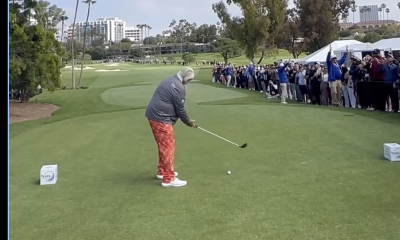
 19th Hole3 days ago
19th Hole3 days agoJohn Daly stuns fans into silence with brutal opening tee shot on PGA Tour Champions
-

 19th Hole1 week ago
19th Hole1 week ago2-time major champ announces shock retirement from the sport at age of 33
-

 19th Hole1 week ago
19th Hole1 week agoEdoardo Molinari reveals the latest PGA Tour golfer to turn down ‘good offer’ from LIV Golf
-

 19th Hole1 week ago
19th Hole1 week agoScottie Scheffler had an interesting response when asked how he ‘quiets the noise’ following Players victory
-

 19th Hole1 week ago
19th Hole1 week agoJon Rahm dealt fresh blow to hopes of qualifying for 2025 Ryder Cup
-

 Equipment2 weeks ago
Equipment2 weeks agoBest driver 2024: The best driver for you, as recommend by expert club fitters
-

 19th Hole3 days ago
19th Hole3 days agoCharlie Woods finds it tough going on American Junior Golf Association debut
-
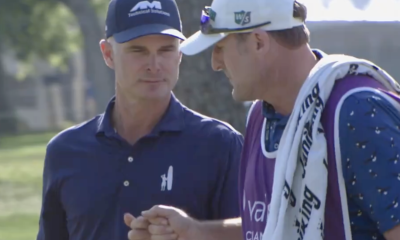
 19th Hole6 days ago
19th Hole6 days agoWhy Kevin Streelman sought USGA approval to use this equipment tool as he leads Valspar after round one



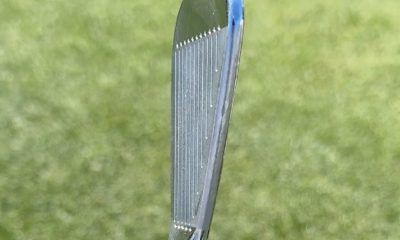

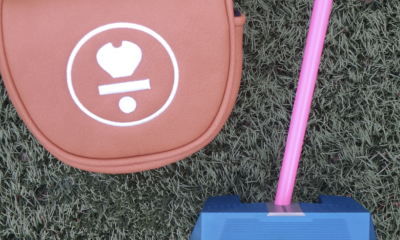

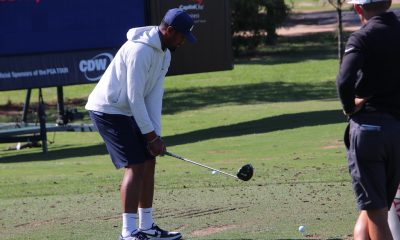



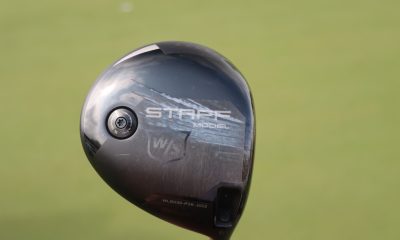

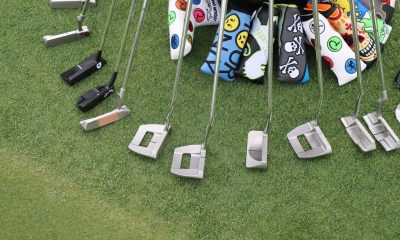















Brad
Aug 3, 2018 at 5:01 am
The best thing to do on many of the bunkers around here is to take your putter or a 7 iron and just chip it out on the lowest side of the bunker, regardless of what direction that may be. Many of the bunkers are like wet concrete around here and the bunker technique used by most pros and taught by most coaching pros is entirely worthless and will only result in a skulled bunker shot 80% or more of the time. I would rather hit a flop shot over a bunker or over a 50 foot tall tree from a hard pan lie than have to get it out of most bunkers.
I would just love to see some of the best pros on tour get out of some of the kind of bunkers we have to play in sometime. There would be no end to the complaints from them I’m sure…
DaveyD
Aug 2, 2018 at 11:02 am
The charts above should be explained by the number of data points used to create the statistics. While the overall trends aren’t surprising and are most likely expected, these types of stats are kept for your players, but less likely to be kept as the handicap increases.
The last comment is in regard to putting, or rather the putting surface- in general. An assumption might be made that better golfers might play on better courses with better-maintained greens which could positively impact putting success.
DaveyD
Aug 2, 2018 at 11:03 am
The “your players” above should be “tour players”
Poot
Aug 2, 2018 at 2:04 am
You ain’t applying this to Links bunkers, that’s for sure. We saw what happened at Carnoustie last week, they were lucky just to get it out.
So, another meaningless “you’re an amateur and you suck” statistical analysis.
Paul
Aug 1, 2018 at 10:54 pm
Makes me feel better about my sand play!
I thought I was pretty average but I’m actually doing ok!
Tom54
Aug 1, 2018 at 2:21 pm
Kevin explains it well. Our bunkers at our course aren’t the greatest either. Depth of sand inconsistent. One shot you hit couple inches behind and it comes out great. Next bunker you’re in there’s no sand, the club bounces into the ball and over the green it goes. Lots of times our group plays move it out of footprints. Pros play off perfect lies why shouldn’t we?
Tee-Bone
Aug 1, 2018 at 1:58 pm
Strokes Gained on the PGA Tour are based on the averages of the field. Where are the averages from with your Strokes Gained programs?
Peter Sanders
Aug 2, 2018 at 9:09 am
Good Q! Our Strokes Gained model is based upon the average Scratch player. We calculate each players SG # vs. Scratch and then compare it to the average SG #’s in each facet for the player’s Target handicap range. It works!
Kevin
Aug 1, 2018 at 11:05 am
Sand save recovery stats are skewed as i’d guess the majority of amateurs aren’t playing courses where the greenside bunkers have several inches of sand and perfectly manicured like on tour. factor in that thousands of courses have little to no sand in some bunkers and the liklihood of a skull is much higher than a pga course. i always find it amusing when watching an instruction program on GC and they mention opening face and hitting 3 inches behind the ball. good luck when you come play in ohio and the bunker is hard packed. and its not goat tracks…a lot of really nice courses simply can’t afford to constantly replace/fill sand in their bunkers.
Mat
Aug 1, 2018 at 5:33 pm
Complete agreement. Sand, believe it or not, is expensive and getting rare. Traps are not worthy of a lot of practice outside of knowing your lie (your feet will tell you how far you sink in is how far behind the ball you enter) and getting out in one shot. If you’re a 10+, that’s the biggest challenge. Get out and two putt for bogey. Don’t take two to get out – that’s the card killer.
Pete McGill
Aug 2, 2018 at 2:08 am
True. My course has one hole with the only two bunkers. Players walk off with either 100% or zero in sand saves.